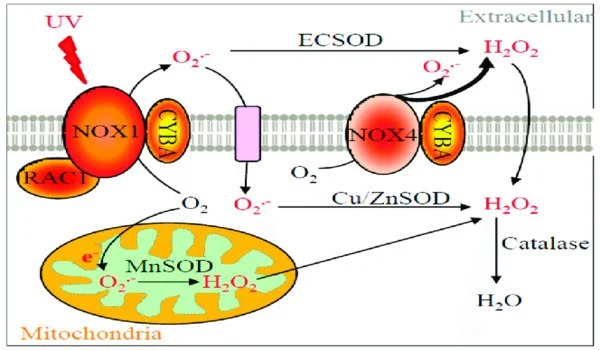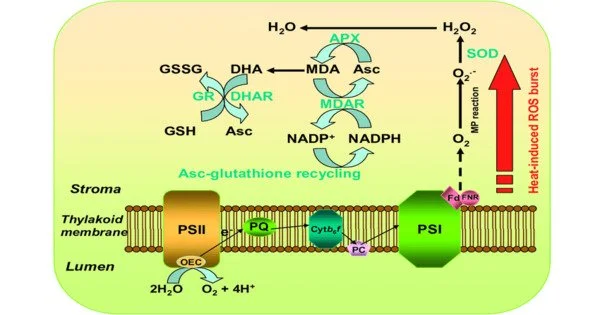Reactive oxygen species (ROS) are extremely reactive molecules that include oxygen. These chemicals, which are natural byproducts of biological activities in all living species, including aerobic respiration and photosynthesis, are extremely hazardous. In most circumstances, ROS damage cellular machinery and can cause a damaging stress response if their levels are not kept under control; this is why antioxidants are an essential element of our diet.
However, over the last few decades, scientists have learned that ROS are frequently purposely produced in cells for a variety of functions. Professor Kazuyuki Kuchitsu of Tokyo University of Science (TUS) has long advocated the hypothesis that ROS acts as a double-edged sword. Prof. Kuchitsu and his colleagues have shown in several studies that plants have many different types of enzymes that produce ROS in a variety of situations, including fighting off fungal or bacterial infection, growth, development, and reproduction (such as fertilization), and adjusting to internal or external stress.
Our results reveal that the binding of calcium ions acts as a molecular switch that activates MpRBOHB, and that the phosphorylation of two specific serine residues plays a role in facilitating this binding.
Dr. Kuchitsu
In some of these investigations, the researchers looked into how plants regulate the activation of ROS-generating enzymes known as NADPH oxidases (RBOHs). They play critical roles not just in plants, but also in animals such as humans and fungus. However, many facets of the biological relevance of this process remain to be investigated. Furthermore, it is critical to tightly control the activity of these enzymes in all species. The evolution of regulatory mechanisms and the function of RBOHs is an important topic in many study domains, including medical and pharmaceutical sciences and microbiology.
So far, two pathways for activating RBOHs have been identified. One involves the binding of calcium ions (Ca2+) to two tiny structures known as EF-hands. The other involves a chemical alteration called phosphorylation of certain amino acids, which is carried out by protein kinases. The precise link between these two processes, as well as how they govern ROS formation, is unclear.
Against this backdrop, a research team led by Prof. Kuchitsu and including Mr. Takafumi Hashimoto, a Ph.D. student, Assistant Professor Kenji Hashimoto, Dr. Shoko Tsuboyama, and Mr. Hiroki Shindo, all from TUS, set out to tackle this knowledge gap in collaboration with Dr. Takuya Miyakawa and Prof. Masaru Tanokura. They previously published a study elucidating the function and regulatory mechanisms of plant RBOHs. Now, in their latest article, which was published in the journal Physiologia Plantarum on 12 December 2023, the team revealed the basic mechanisms via which MpRBOHB, an ROS-generating RBOH, is activated. Interestingly, these mechanisms seem to be conserved in RBOHs across all land plants.

The researchers first showed, through experiments with the liverwort model Marchantia polymorpha and genetically modified cell lines, that the activation of MpRBOHB requires not only an increase in intracellular Ca2+ concentration but also binding with Ca2+ ions at two regions in EF-hands spanning about 200 amino acids. In these tests, they used chitin fragments to trigger an immune response in the cells as chitin is an essential component of the cell walls of microorganisms such as molds and fungi.
Following a thorough investigation of the highly conserved areas around the EF-hands in all terrestrial plants, the researchers discovered two serine amino acid residues that, when phosphorylated, boost the Ca2+ binding affinity of MpRBOHB. “Our results reveal that the binding of calcium ions acts as a molecular switch that activates MpRBOHB, and that the phosphorylation of two specific serine residues plays a role in facilitating this binding,” says Dr. Kuchitsu. “We believe that these mechanisms, orchestrated by a conserved regulatory domain, constitute fundamental regulatory processes governing all land plant RBOHs.”
Understanding how plants regulate ROS-producing enzymes could have tremendous implications for humanity. The insights obtained could lead to tools for manipulating ROS production artificially in plants. In turn, this ability could be used to increase crop yields, make plants more resilient to pollutants or invasive microorganisms, and even leverage plants to clean environmental pollutants.
“The production of ROS serves a variety of important functions in plants, including growth, reproduction, immunity, and stress response.” According to Prof. Kuchitsu, appropriate control over this production could assist us enhance agriculture and food quality while also aiding in environmental rehabilitation. “This work will hopefully contribute to solving a wide range of social problems related to plants by serving as an extremely important basis for future research.”
















